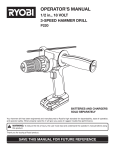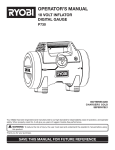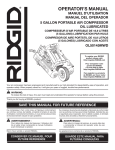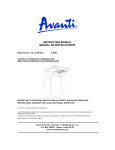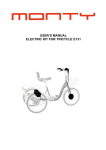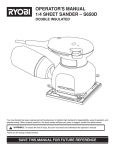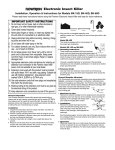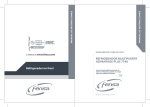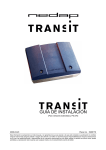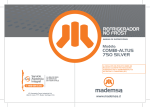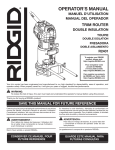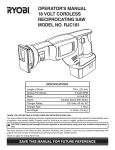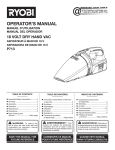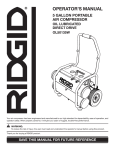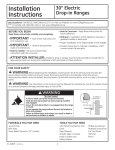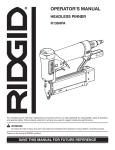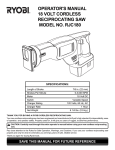Download Ryobi YG601PV1 Use and Care Manual
Transcript
OPERATOR’S MANUAL MANUEL D’UTILISATION MANUAL DEL OPERADOR 6 GAL. AIR COMPRESSOR COMPRESSEUR D’AIRE DE 22,71 L (6 GAL.) COMPRESOR AIRE DE 22,71 L (6 GAL.) YG601PV1 TABLE OF CONTENTS TABLE DES MATIÈRES ÍNDICE DE CONTENIDO **************** **************** **************** General Safety Rules........................3-4 Règles de sécurité générales...........3-4 Règles de sécurité particulières.......4-5 Symboles..........................................6-7 Caractéristiques électriques................ 8 Glossaire..............................................9 Caractéristiques.................................. 9 Assemblage....................................... 10 Utilisation......................................10-12 Entretien............................................13 Dépannage...................................14-15 Illustrations...................................16-17 Commande de pièces / réparation...........................Page arrière Reglas de seguridad generales........3-4 Reglas de seguridad específicas.....4-5 Símbolos..........................................6-7 Aspectos eléctricos............................. 8 Glosario de términos........................... 9 Características.................................... 9 Armado..............................................10 Funcionamiento............................10-12 Mantenimiento................................... 13 Solución de problemas................14-15 Ilustraciones.................................16-17 Pedidos de piezas / servicio........................... Pág. posterior WARNING: To reduce the risk of injury, the user must read and understand the operator’s manual before using this product. AVERTISSEMENT : Pour réduire les risques de blessures, l’utilisateur doit lire et veiller à bien comprendre le manuel d’utilisation avant d’employer ce produit. ADVERTENCIA: Para reducir el riesgo de lesiones, el usuario debe leer y comprender el manual del operador antes de usar este producto. SAVE THIS MANUAL FOR FUTURE REFERENCE CONSERVER CE MANUEL POUR FUTURE RÉFÉRENCE GUARDE ESTE MANUAL PARA FUTURAS CONSULTAS Specific Safety Rules.......................4-5 Symbols............................................6-7 Electrical..............................................8 Glossary of Terms................................ 9 Features...............................................9 Assembly...........................................10 Operation......................................10-12 Maintenance...................................... 13 Troubleshooting............................14-15 Illustrations...................................16-17 Parts Ordering / Service...... Back Page DANGER: This compressor/pump is not equipped and should not be used to supply breathing quality air. Additional equipment would be necessary to properly filter and purify the air to meet minimal specifications for Grade D breathing as described in Compressed Gas Association Commodity Specification G 7.1 - 1966, OSHA 29 CFR 1910.134. Compressed Gas Association, 4221 Walney Road, Fifth Floor, Chantilly, VA 20151-2923, (703) 788-2700, www.cganet.com. Any such additional equipment has not been examined and no implication of proper use for breathing air is intended or implied. If this compressor is altered in any way, existing warranties shall be voided. RYOBI and One World Technologies, Inc., disclaim any liabilities whatsoever for any loss, personal injury, or damage. DISCLAIMER OF WARRANTIES In the event the compressor is used for the purpose of breathing air application and proper in-line safety and alarm equipment is not simultaneously used, existing warranties shall be voided, and RYOBI disclaims any liabilities whatsoever for any loss, personal injury, or damage. DANGER : Ce compresseur / pompe n’est pas équipé et ne doit pas être utiliser pour fournir de l’air de qualité respirable. Un équipement supplémentaire est nécessaire pour filtrer et purifier l’air conformément aux spécifications minimum d’air respirable de qualité D G 7.1 - 1966, OSHA 29 CFR 1910. 134 de la Compressed Gas Association, 4221 Walney Road, Fifth Floor, Chantilly, VA 20151-2923, (703) 788-2700, www.cganet.com. Un tel équipement n’a pas été examiné et nulle implacation d’utilisation propre pour l’air respirable n’est prévue ou implicite. Si ce compresseur est modifier de quelle que manière que ce soit, les garanties en vigueur seront déclarées nulles et non avenues. RYOBI. et One World Technologies, Inc., déclineront toute responsabilité pour les pertes, blessures et dommages résultant de son utilisation. EXONÉRATION DE GARANTIES Si ce compresseur est utilisé pour des applications d’air respirable sans un système de sécurité et d’alarme approprié, les garanties en vigueur seront déclarées nulles et non avenues et RYOBI déclinera toute responsabilité pour les pertes, blessures et dommages résultant de son utilisation. PELIGRO: Este compresor (o bomba) no está equipado y debe evitarse utilizarlo para suministrar aire para respirar. Es necesario equipo adicional para filtrar y purificar debidamente el aire a fin de que cumpla las especificaciones mínimas de Grado D para respiración, según se explica en la Especificación de Productos G 7.1 - 1966 de la Asociación de Proveedores de Equipo de Gas Comprimido (Compressed Gas Association), OSHA 29 CFR 1910.134. Compressed Gas Association, 4221 Walney Road, Fifth Floor, Chantilly, VA 20151-2923, (703) 788-2700, www.cganet.com. Tal equipo adicional no ha sido examinado y no debe suponerse o deducirse ninguna conclusión con respecto al correcto uso del aire de respiración. Si se altera de cualquier forma este compresor, quedan anuladas todas las garantías presentes. RYOBI y One World Technologies, Inc., se eximen de toda responsabilidad de cualquier tipo por cualquier pérdida, lesión corporal o daño material. EXTENCIÓN DE RESPONSABILIDAD DE LAS GARANTÍAS En caso de utilizarse los compresores para suministrar aire de respiración, y no utilizarse simultáneamente equipo en línea de seguridad y alarma apropiado, se anulan todas las garantías presentes, y RYOBI se exime de toda responsabilidad de cualquier tipo por cualquier pérdida, lesión física o daño material que resulte. 2 GENERAL SAFETY RULES WARNING: Read and understand all instructions. Failure to follow all instructions listed below may result in electric shock, fire, and/or serious personal injury. SAVE THESE INSTRUCTIONS WORK AREA Keep your work area clean and well lit. Cluttered benches and dark areas invite accidents. Floor must not be slippery from wax or dust. Do not operate air compressors in explosive atmospheres, such as in the presence of flammable liquids, gases, or dust. Power tools create sparks which may ignite the dust or fumes. Keep bystanders, children, and visitors away while operating an air compressor. Distractions can cause you to lose control. Operate air compressor in an open area at least 18 in. away from any wall or object that could restrict the flow of fresh air to ventilation openings. ELECTRICAL SAFETY Avoid body contact with grounded surfaces such as pipes, radiators, ranges, and refrigerators. There is an increased risk of electric shock if your body is grounded. Don’t expose air compressors to rain or wet conditions. Water entering an air compressor will increase the risk of electric shock. Do not abuse the cord. Never use the cord to carry the air compressor or pull the plug from an outlet. Keep cord away from heat, oil, sharp edges, or moving parts. Replace damaged cords immediately. Damaged cords increase the risk of electric shock. Additional safety protection will be required in some environments. For example, the working area may include exposure to a noise level which can lead to hearing damage. The employer and user must ensure that any necessary hearing protection is provided and used by the operator and others in the work area. Some environments will require the use of head protection equipment. When required, the employer and user must ensure that head protection marked to comply with ANSI Z89.1 is used. Stay alert, watch what you are doing, and use common sense when operating the air compressor. Do not use product while tired or under the influence of drugs, alcohol, or medication. A moment of inattention while operating an air compressor may result in serious personal injury. Dress properly. Do not wear loose clothing or jewelry. Contain long hair. Keep your hair, clothing, and gloves away from moving parts. Loose clothes, jewelry, or long hair can be caught in moving parts. Do not overreach. Keep proper footing and balance at all times. Proper footing and balance enables better control of the product in unexpected situations. Use safety equipment. Always wear eye protection. Dust mask, nonskid safety shoes, hard hat, or hearing protection must be used for appropriate conditions. Do not use on a ladder or unstable support. Stable footing on a solid surface enables better control of the air compressor in unexpected situations. AIR COMPRESSOR USE AND CARE Do not exceed the pressure rating of any component in the system. Protect material lines and air lines from damage or puncture. Keep hose and power cord away from sharp objects, chemical spills, oil, solvents, and wet floors. When operating an air compressor outside, use an outdoor extension cord marked “W-A” or “W”. These cords are rated for outdoor use and reduce the risk of electric shock. Check hoses for weak or worn condition before each use, making certain all connections are secure. Do not use if defect is found. Purchase a new hose or notify an authorized service center for examination or repair. PERSONAL SAFETY Release all pressures within the system slowly. Dust and debris may be harmful. Eye protection which conforms to ANSI specifications and provides protection against flying particles both from the FRONT and SIDE should ALWAYS be worn by the operator and others in the work area when loading, operating, or servicing this product. Eye protection is required to guard against flying fasteners and debris, which could cause severe eye injury. The employer and/or user must ensure that proper eye protection is worn. We recommend a Wide Vision Safety Mask for use over eyeglasses or standard safety glasses that provide protection against flying particles both from the front and side. Always use eye protection which is marked to comply with ANSI Z87.1. Store idle air compressors out of the reach of children and other untrained persons. Air compressors are dangerous in the hands of untrained users. Maintain air compressors with care. Follow maintenance instructions. Properly maintained products are easier to control. Check for misalignment or binding of moving parts, breakage of parts, and any other condition that may affect the product’s operation. If damaged, have the air compressor serviced before using. Many accidents are caused by poorly maintained products. 3 – English GENERAL SAFETY RULES Keep the exterior of the air compressor dry, clean, and free from oil and grease. Always use a clean cloth when cleaning. Never use brake fluids, gasoline, petroleumbased products, or any strong solvents to clean the unit. Following this rule will reduce the risk of deterioration of the enclosure plastic. SERVICE When servicing a product, use only identical replacement parts. Follow instructions in the Maintenance section of this manual. Use of unauthorized parts or failure to follow Maintenance instructions may create a risk of injury. Service must be performed only by qualified repair personnel. Service or maintenance performed by unqualified personnel may result in a risk of injury. Disconnect power supply, open drain valve to decompress tanks and allow water to drain, and allow air compressor to become cool to the touch before servicing. Turn pressure regulator knob fully counterclockwise after shutting off air compressor. SPECIFIC SAFETY RULES Know your air compressor. Read operator’s manual carefully. Learn its applications and limitations, as well as the specific potential hazards related to this product. Following this rule will reduce the risk of electric shock, fire, or serious injury. Drain tanks of moisture after each day’s use. If unit will not be used for a while, it is best to leave drain valve open until such time as it is to be used. This will allow moisture to completely drain out and help prevent corrosion on the inside of tanks. Risk of Fire or Explosion. Do not spray flammable liquid in a confined area. Spray area must be well ventilated. Do not smoke while spraying or spray where spark or flame is present. Keep compressors as far from the spraying area as possible, at least 20 feet from the spraying area and all explosive vapors. Risk of Bursting. Do not adjust regulator to result in output pressure greater than marked maximum pressure of attachment. Do not use at pressure greater than 150 psi. If connected to a circuit protected by fuses, use timedelay fuses with this product. To reduce the risk of electric shock, do not expose to rain. Store indoors. Inspect tanks yearly for rust, pin holes, or other imperfections that could cause it to become unsafe. Never weld or drill holes in the air tanks. Make sure the hose is free of obstructions or snags. Entangled or snarled hoses can cause loss of balance or footing and may become damaged. Use the air compressor only for its intended use. Do not alter or modify the unit from the original design or function. A lways be aware that misuse and improper handling of this product can cause injury to yourself and others. Never leave a tool unattended with the air hose attached. Never point any air tool toward yourself or others. Do not operate this air compressor if it does not contain a legible warning label. Do not continue to use a tool or hose that leaks air or does not function properly. Always disconnect the air supply and power supply before making adjustments, servicing a product, or when a product is not in use. Do not attempt to pull or carry the air compressor by the hose. Your tool may require more air consumption than this air compressor is capable of providing. Always follow all safety rules recommended by the manufacturer of your air tool, in addition to all safety rules for the air compressor. Following this rule will reduce the risk of serious personal injury. N ever direct a jet of compressed air toward people or animals. Take care not to blow dust and dirt towards yourself or others. Following this rule will reduce the risk of serious injury. Do not use this air compressor to spray chemicals. Your lungs can be damaged by inhaling toxic fumes. A respirator may be necessary in dusty environments or when spraying paint. Do not carry while painting. Inspect product cords and hoses periodically and, if damaged, have repaired at your nearest Authorized Service Center. Constantly stay aware of cord location. Following this rule will reduce the risk of electric shock or fire. Never use an electrical adaptor with this grounded plug. 4 – English SPECIFIC SAFETY RULES Check damaged parts. Before further use of the air compressor or air tool, a guard or other part that is damaged should be carefully checked to determine that it will operate properly and perform its intended function. Check for alignment of moving parts, binding of moving parts, breakage of parts, mounting, and any other conditions that may affect its operation. A guard or other part that is damaged should be properly repaired or replaced by an authorized service center. Following this rule will reduce the risk of shock, fire, or serious injury. Make sure your extension cord is in good condition. When using an extension cord, be sure to use one heavy enough to carry the current your product will draw. A wire gauge size (A.W.G.) of at least 14 is recommended for an extension cord 25 feet or less in length. A cord exceeding 50 feet is not recommended. If in doubt, use the next heavier gauge. The smaller the gauge number, the heavier the cord. An undersized cord will cause a drop in line voltage resulting in loss of power and overheating. This equipment incorporates parts, such as snap switches, receptacles, and the like that tend to produce arcs or sparks and, therefore, when located in a garage, it should be in a room or enclosure provided for the purpose, or should be 18 in. (457 mm) or more above the floor. Never store a tool with air connected. Storing the tool with air connected can result in unexpected firing and possible serious personal injury. Protect your lungs. Wear a face or dust mask if the operation is dusty. Following this rule will reduce the risk of serious personal injury. If the power supply cord is damaged, it must be replaced only by the manufacturer or by an authorized service center to avoid risk. Save these instructions. Refer to them frequently and use them to instruct others who may use this product. If you loan someone this product, loan them these instructions also. 5 – English SYMBOLS The following signal words and meanings are intended to explain the levels of risk associated with this product. SYMBOL SIGNAL MEANING DANGER: Indicates an imminently hazardous situation, which, if not avoided, will result in death or serious injury. WARNING: Indicates a potentially hazardous situation, which, if not avoided, could result in death or serious injury. CAUTION: Indicates a potentially hazardous situation, which, if not avoided, may result in minor or moderate injury. NOTICE: (Without Safety Alert Symbol) Indicates important information not related to an injury hazard, such as a situation that may result in property damage. Some of the following symbols may be used on this product. Please study them and learn their meaning. Proper interpretation of these symbols will allow you to operate the product better and safer. SYMBOL NAME DESIGNATION/EXPLANATION Safety Alert Indicates a potential personal injury hazard. Read Operator’s Manual To reduce the risk of injury, user must read and understand operator’s manual before using this product. Eye Protection Always wear eye protection with side shields marked to comply with ANSI Z87.1. Wet Conditions Alert Do not expose to rain or use in damp locations. Risk of Bursting Do not adjust regulator to result in output pressure greater than marked maximum pressure of attachment. Do not use at pressure greater than 150 psi. Risk of Fire or Explosion Do not spray flammable liquid in a confined area. Spray area must be well ventilated. Do not smoke while spraying or spray where spark or flame is present. Keep compressors as far from the spraying area as possible, at least 15 feet from the spraying area and all explosive vapors. Risk of Electrical Shock Hazardous Voltage: Disconnect from power source before servicing. Compressor must be grounded. Hot Surface To reduce the risk of injury or damage, avoid contact with any hot surface. Risk to Breathing Air obtained directly from the air compressor should never be used to supply air for human consumption. 6 – English SYMBOLS Some of the following symbols may be used on this product. Please study them and learn their meaning. Proper interpretation of these symbols will allow you to operate the product better and safer. SYMBOL NAME DESIGNATION/EXPLANATION V Volts Voltage A Amperes Current Hz Hertz Frequency (cycles per second) Alternating Current Type of current Class II Construction Double-insulated construction CALIFORNIA PROPOSITION 65 WARNING: This product and some dust created by power sanding, sawing, grinding, drilling, and other construction activities may contain chemicals, including lead, known to the State of California to cause cancer, birth defects, or other reproductive harm. Wash hands after handling. Some examples of these chemicals are: • lead from lead-based paints, • crystalline silica from bricks and cement and other masonry products and, • arsenic and chromium from chemically treated lumber. Your risk from exposure to these chemicals varies, depending on how often you do this type of work. To reduce your exposure, work in a well-ventilated area and with approved safety equipment, such as dust masks that are specially designed to filter out microscopic particles. 7 – English ELECTRICAL EXTENSION CORDS SPEED AND WIRING Use only 3-wire extension cords that have 3-prong grounding plugs and 3-pole receptacles that accept the product’s plug. When using a power tool at a considerable distance from the power source, use an extension cord heavy enough to carry the current that the tool will draw. An undersized extension cord will cause a drop in line voltage, resulting in a loss of power and causing the motor to overheat. Use the chart provided below to determine the minimum wire size required in an extension cord. Only round jacketed cords listed by Underwriter’s Laboratories (UL) should be used. The no-load speed of this product is approximately 18,000 rpm. This speed is not constant and decreases under a load or with lower voltage. For voltage, the wiring in a shop is as important as the motor’s horsepower rating. A line intended only for lights cannot properly carry an air compressor motor. Wire that is heavy enough for a short distance will be too light for a greater distance. A line that can support one power tool may not be able to support two or three tools. **Ampere rating (on product data plate) 0-2.0 2.1-3.4 3.5-5.0 5.1-7.0 7.1-12.0 12.1-16.0 Cord LengthWire Size (A.W.G.) 25'16 16161614 14 50'16 16161414 12 100'16 16141210 — **Used on 12 gauge - 20 amp circuit. NOTE: AWG = American Wire Gauge When working with the product outdoors, use an extension cord that is designed for outside use. This is indicated by the letters “W-A” or “W” on the cord’s jacket. Before using an extension cord, inspect it for loose or exposed wires and cut or worn insulation. WARNING: Keep the extension cord clear of the working area. Position the cord so that it will not get caught on lumber, tools, or other obstructions while you are working with a power tool. Failure to do so can result in serious personal injury. WARNING: Check extension cords before each use. If damaged replace immediately. Never use the product with a damaged cord since touching the damaged area could cause electrical shock resulting in serious injury. GROUNDING INSTRUCTIONS This product must be grounded. In the event of a malfunction or breakdown, grounding provides a path of least resistance for electric current to reduce the risk of electric shock. This product is equipped with an electric cord having an equipment-grounding conductor and a grounding plug. The plug must be plugged into a matching outlet that is properly installed and grounded in accordance with all local codes and ordinances. Do not modify the plug provided. If it will not fit the outlet, have the proper outlet installed by a qualified electrician. WARNING: Improper installation of the grounding plug is liable to result in a risk of electric shock. When repair or replacement of the cord is required, do not connect the grounding wire to either flat blade terminal. The wire with insulation having an outer surface that is green with or without yellow stripes is the grounding wire. Check with a qualified electrician or service personnel if the grounding instructions are not completely understood, or if in doubt as to whether the product is properly grounded. Repair or replace a damaged or worn cord immediately. This product is for use on a nominal 120 V circuit and has a grounding plug similar to the plug illustrated in figure 1, page 16. Only connect the product to an outlet having the same configuration as the plug. Do not use an adaptor with this product. ELECTRICAL CONNECTION This product is powered by a precision-built electric motor. It should be connected to a power supply that is 120 V, AC only (normal household current), 60 Hz. Do not operate this product on direct current (DC). A substantial voltage drop will cause a loss of power and the motor will overheat. If the product does not operate when plugged into an outlet, double check the power supply. 8 – English GLOSSARY OF TERMS Air Filter Pressure Regulator Knob Porous element contained within a metal or plastic housing attached to the compressor cylinder head which removes impurities from the intake air of the compressor. Regulates the outgoing pressure from the air outlet to the tool. It is possible to increase or decrease the pressure at the outlet by adjusting this control knob. Air Tank Pressure Switch Cylindrical component which contains the compressed air. Automatically controls the on/off cycling of the compressor. It stops the compressor when the cut-off pressure in the tank is reached and starts the compressor when the air pressure drops below the cut-in pressure. Check Valve Device that prevents compressed air from flowing back from the air tank to the compressor pump. Cut-In Pressure The low pressure at which the motor will automatically restart. Cut-Off Pressure The high pressure at which the motor will automatically shut off. Electric Motor Device which provides the rotational force necessary to operate the compressor pump. NPT (National Pipe Thread) A seal thread tape must be used to provide a leak-free seal on pipe threaded connections. On/Off Switch PSI (Pounds Per Square Inch) Measurement of the pressure exerted by the force of the air. The actual psi is measured by a pressure gauge on the compressor. Pump Produces the compressed air with a reciprocating piston contained within the cylinder. Regulator Pressure Gauge Displays the current line pressure. Line pressure is adjusted by rotating the pressure regulator knob. Safety Valve Prevents air pressure in the air tank from rising over a predetermined limit. Control which turns the air compressor on or off. The pressure switch will not automatically start and control the compressor unless the manual On/Off Switch is in the ON( l ) position. SCFM (Standard Cubic Feet Per Minute) or CFM (Cubic Feet Per Minute) Overload Switch (Integral to Switch) Tank Pressure Gauge Automatically shuts off the compressor if the temperature of the electric motor exceeds a predetermined limit. Indicates the pressure in the air tank. A unit of measure of air delivery. FEATURES PRODUCT SPECIFICATIONS Air Tank Capacity............................................................................................................................................................ 6 gal. Air Pressure..........................................................................................................................................................150 psi max. Air Delivery................................................................................................................................................ 2.6 SCFM @ 90 psi Gauges............................................................................................................................................................... 2 in. diameter Input...................................................................................................................................... 120 V, AC only, 60 Hz, 11 Amps 9 – English ASSEMBLY WARNING: WARNING: Do not use this product if it is not completely assembled or if any parts appear to be missing or damaged. Use of a product that is not properly and completely assembled or with damaged or missing parts could result in serious personal injury. Do not attempt to modify this product or create accessories or attachments not recommended for use with this product. Any such alteration or modification is misuse and could result in a hazardous condition leading to possible serious personal injury. If any parts are damaged or missing, please call 1-800-525-2579 for assistance. OPERATION WARNING: DANGER: Do not disassemble check valve, tank drain valve, or safety valve with air in tank — bleed tanks. Failure to depressurize tank could result in explosion and/or serious personal injury. WARNING: Do not allow familiarity with products to make you careless. Remember that a careless fraction of a second is sufficient to inflict severe injury. WARNING: Always wear eye protection with side shields marked to comply with ANSI Z87.1. Failure to do so could result in objects being thrown into your eyes resulting in possible serious injury. WARNING: Do not use any attachments or accessories not recommended by the manufacturer of this product. The use of attachments or accessories not recommended can result in serious personal injury. WARNING: This equipment incorporates parts, such as snap switches, receptacles, and the like that tend to produce arcs or sparks and, therefore, when located in a garage, it should be in a room or enclosure provided for the purpose, or should be 18 in. or more above the floor. Do not attach any tools to the open end of the hose until start-up has been completed. NOTICE: Do not use in an environment that is dusty or otherwise contaminated. Using the air compressor in this type of environment may cause damage to the unit. NOTICE: The wiring to a receptacle and the length of any extension cords being used play an important role in the operation of this product. Wiring intended for lights cannot properly carry an air compressor motor, and wire that is heavy enough for a short distance may be insufficient for a greater distance. Before using this product, verify your receptacle is wired appropriately for air compressor use and the length and gauge of any extension cord used is sufficient to carry the current of the air compressor. APPLICATIONS Air compressors are utilized in a variety of air system applications. Match hoses, connectors, air tools, and accessories to the capabilities of the air compressor. You may use this product for the purposes listed below: Operating some air-powered tools Operating air accessories such as air nozzles and tire inflators 10 – English OPERATION CONNECTING/DISCONNECTING AIR HOSE WARNING: See Figure 2, page 16. Never exceed the air tool’s pressure rating as recommended by the manufacturer. When using this air compressor as an inflation device, always follow the maximum inflation guidelines stated by the manufacturer of the item being inflated. WARNING: Never exceed the air tool’s pressure rating as recommended by the manufacturer. When using this air compressor as an inflation device, always follow the maximum inflation guidelines stated by the manufacturer of the item being inflated. WARNING: Always ensure the switch is in the OFF (O) position and the regulator pressure gauge reads zero before changing air tools or disconnecting the hose from the air outlet. Failure to do so could result in possible serious personal injury. n Make sure the air compressor is off and unplugged. n Rotate pressure regulator knob fully in the counterclockwise direction so that the outlet pressure is at zero (0) psi. n Attach an air hose with 1/4 in. NPT quick-connect air fitting to a quick connect coupler (1/4 in.) on air compressor. Make sure to push the air fitting fully into the coupler until the sleeve springs forward to lock in place. USING THE AIR COMPRESSOR See Figure 4, page 17. n To lessen the chance of the air compressor becoming unbalanced during use, route the air hose through the corresponding hose channel on the bottom of the unit, out the nearest side, then over to your worksite. WARNING: Risk of bursting. Do not adjust pressure regulator knob to result in output pressure greater than marked maximum pressure of attachment and/or the item being inflated. Never use at pressure greater than 150 psi. Failure to heed this warning could result in possible serious personal injury. To disconnect an air hose or an air tool: n Confirm that the outlet pressure is at zero (0) psi. n When disconnecting a hose from quick connect coupler (1/4 in.), always firmly hold fitting end of hose. n Push back on the release sleeve on the 1/4 in. quickconnect coupler. WARNING: n With a firm grip, pull out the quick-connect air fitting that is attached to the quick connect coupler. Air powered tools may require more air consumption than this air compressor is capable of providing. Check the tool manual to avoid damage to the tool or risk of personal injury. BREAK-IN PERIOD Before first use, run the air compressor at zero (0) tank pressure with the drain valve fully open for 30 minutes. TURNING THE AIR COMPRESSOR ON/OFF See Figure 3, page 17. n With the air compressor plugged in, turn the on/off switch to the ON position to power the compressor on. n To turn the air compressor off, turn the on/off switch to the OFF position. NOTE: When the compressor is in the ON position, the air compressor will automatically turn back on when the designated tank air pressure drops below the preset pressure limit. It will also shut off again when the desired pressure is reached. n Attach air hose following the instructions in Connecting/ Disconnecting Air Hose (Not Provided). n Set the amount of air pressure desired using the pressure regulator knob. Pull the knob up, then turn clockwise to increase or counterclockwise to decrease the air pressure to be provided through the hose. When the desired pressure is set, push the knob back down to lock. NOTE: Always use the minimum amount of pressure necessary for your application. Using a higher pressure than needed will drain air from the tank more rapidly and cause the unit to cycle on more frequently. n When finished, always drain the tank and unplug the unit. Never leave the unit plugged in and/or running unattended. 11 – English ASSEMBLY RESETTING THE AIR COMPRESSOR CHECKING THE SAFETY VALVE When amperage into the air compressor exceeds the specified amperage, the air compressor will automatically shut off. See Figure 5, page 17. To reset the air compressor: Do not attempt to tamper with the safety valve. Anything loosened from this device could fly up and hit you. Failure to heed this warning could result in death or serious personal injury. n Turn the air compressor off. n Unplug the air compressor. n Plug the air compressor into an approved outlet. n Turn the air compressor on. DRAINING THE TANK See Figure 5 - 6, page 17. To help prevent tank corrosion and keep moisture out of the air used, the air tank of the compressor should be drained daily. To drain: n Turn the air compressor OFF and disconnect the plug from the power supply, n Pull the ring on the safety valve to release pressure until pressure gauge reads less than 20 psi. n Release the ring. n Rotate drain valve counterclockwise to open. n Tilt tank as shown to drain moisture from tank into a suitable container. DANGER: NOTE: Condensate is a polluting material and should be disposed of in compliance with local regulations. n If drain valve is clogged, release all air pressure, remove and clean valve, then reinstall. WARNING: Unplug the air compressor and release all air from the tank before servicing. Failure to depressurize tank before attempting to remove valve can cause serious personal injury. The safety valve will automatically release air if the air tank pressure exceeds the preset maximum. The valve should be checked before each day of use by pulling the ring by hand. n Turn the air compressor on and allow the tank to fill. The compressor will shut off when the pressure reaches the preset maximum. n Turn the air compressor off. n Pull the ring on the safety valve to release air for three to five seconds to allow pressurized air to escape. Release the ring. The safety release valve must reset and hold pressure before all compressed air is exhausted from the tank/pressure vessel. n Any continued loss of air after performing the above steps indicates a problem with the safety valve. Discontinue use and seek service before continued use of the air compressor. WARNING: If air leaks after the ring has been released or if the valve is stuck and cannot be actuated by the ring, do not use the air compressor until the safety valve has been replaced. Use of the air compressor in this condition could result in serious personal injury. n Rotate drain valve clockwise until tightly closed. WARNING: RISK OF BURSTING. All compressed air tanks have a limited lifespan. The lifespan can be affected by a number of factors, including operating conditions of the air compressor, proper maintenance of the tank, and unauthorized repairs and modifications. Since deterioration of the tank can occur internally with no outward signs, the air tank(s) on this compressor MUST be removed from service by the end of the year shown on the data label. Use of the air compressor after this date increases the risk of an air tank rupture, which could result in serious personal injury. 12 – English OPERATION CLEANING THE AIR FILTER WARNING: When servicing use only identical replacement parts. Use of any other parts may create a hazard or cause product damage. WARNING: Always wear eye protection with side shields marked to comply with ANSI Z87.1. Failure to do so could result in objects being thrown into your eyes resulting in possible serious injury. WARNING: Always release all pressure, disconnect from power supply, and allow unit to cool to the touch before cleaning or making repairs on the air compressor. See Figure 7, page 17. Loosen the four screws securing the cover to the unit. Lift the cover off and set aside. Loosen the screw securing the air filter housing to the motor until the housing can be removed. Remove the screw and the back from the air filter housing and set aside. Remove the foam filter from the air filter housing. Wash with warm, soapy water and rinse clean. Set aside and allow to dry completely. Reinstall the air filter, then replace the back on the housing. NOTE: Do not run the motor without the air filter installed. Doing so will cause premature wear to the motor. Replace air filter housing on motor and reinstall screw. Tighten securely. GENERAL MAINTENANCE Replace the cover of the unit. Reinstall screws and tighten securely. Avoid using solvents when cleaning plastic parts. Most plastics are susceptible to damage from various types of commercial solvents and may be damaged by their use. Use clean cloths to remove dirt, dust, oil, grease, etc. REPLACING GAUGES, QUICK CONNECT COUPLERS OR SAFETY VALVE WARNING: Do not at any time let brake fluids, gasoline, petroleumbased products, penetrating oils, etc., come in contact with plastic parts. Chemicals can damage, weaken or destroy plastIc which may result in serious personal injury. See Figure 8, page 17. Pull the pressure regulator knob straight up and remove. Remove four screws securing the console cover. Remove cover and set aside. Using an adjustable wrench, remove the item(s) to be replaced (gauges, quick connect couplers, and/or safety valve) from the regulator manifold. Apply pipe sealant to new part(s) and then install new parts on manifold. Tighten securely. NOTE: If replacing gauges, make sure to orient new gauges correctly for reading. Reinstall console cover and replace screws. Tighten securely. NOTE: ILLUSTRATIONS START ON PAGE 16 AFTER FRENCH AND SPANISH LANGUAGE SECTIONS. This product has a Three-year Limited Warranty. For Warranty details go to www.ryobitools.com 13 – English TROUBLESHOOTING PROBLEM Compressor will not run CAUSE SOLUTION Loss of power or overheating Check for proper use of extension cord. No electrical power Check to be sure unit is plugged in. Check fuse/breaker. Insufficient power from receptacle Use a receptacle on a different circuit. Insufficient power from extension cord Refer to chart on page 8 to choose an appropriate extension cord. Blown shop/house fuse Replace shop/house blown fuse. Shop/house breaker open Reset shop/house breaker, determining why problem happened. Amperage overload open Move compressor to well-ventilated area. Unit must be unplugged and allowed to cool for 30 minutes to initiate reset. Pressure switch bad Take compressor to service center. Tank is full of air Compressor will turn on when tank pressure drops to cut-in pressure. Motor hums but cannot run or Low voltage Check with voltmeter. runs slowly Wrong gauge wire or length of extension cord Check for proper gauge wire and cord length. Shorted or open motor winding Take compressor to service center. Defective check valve Take compressor to service center. Insufficient power from receptacle Use a receptacle on a different circuit. Insufficient power from extension cord Refer to chart on page 8 to choose an appropriate extension cord. Amperage overload protector Low voltage Check with volt meter. cuts out repeatedly Lack of proper ventilation/room temperature Move compressor to well-ventilated area. too high Unit must be unplugged and allowed to cool for 30 minutes to initiate reset. Wrong gauge wire or length of extension cord Check for proper gauge wire and cord length. Insufficient power from extension cord Air tank pressure drops when Loose connections (fittings, tubing, etc.) compressor shuts off Refer to chart on page 8 to choose an appropriate extension cord. Check all connections with soap and water solution and tighten. Loose drain valve/open drain valve Tighten drain valve/close drain valve. Check valve leaking Take compressor to service center. DANGER: Do not disassemble check valve, tank drain valve, or safety valve with air in tank — bleed tank. 14 – English TROUBLESHOOTING PROBLEM CAUSE Excessive moisture in discharge air Excessive water in air tank Drain tank. High humidity Move to area of less humidity; use air line filter. Compressor runs continuously Defective pressure switch Air output lower than normal SOLUTION Take compressor to service center. Excessive air usage Decrease air usage; compressor not large enough for tool’s requirement. Piston seal is worn Replace piston seal; call customer service for assistance. Broken inlet valves or worn seal and cylinder Take compressor to service center. Connections leaking Tighten connections. Drain valve not fully closed Close drain valve. 15 – English YG601PV1 Fig. 1 G B I C A B D A A-Grounding pin (broche de terre, patilla de conexión a tierra) B-120 V Grounded outlet (prise secteur 120 V mise à la terre, toma de corriente de 120 V con conexión a tierra) Fig. 2 J B A H C D F E A-On/off switch (commutateur marche / arrêt, interruptor encendido/apagado) B-Tank pressure gauge (manomètre de réservoir , manómetro del tanque) C-Regulator pressure gauge (manomètre du régulateur, regulador de presión manométrica) D-Safety valve (soupape de sûreté, boquilla de la seguridad) E-Drain valve (soupape de vidange, válvula de drenaje) F-Hose channel (rainure de flexible, canal de la manguera) G-Folding carry handle (poignée de transport pliable, mango de transporte plegable) H-Power cord (cordon d’alimentation, cordón eléctrical) I-Pressure regulator knob (bouton de régulateur de pression, perilla de regulación de presión) J-Quick connect coupler (coupleur à ressort, acoplador de conexión rápida) 16 A - Pressure regulator knob (bouton de régulateur de pression, perilla de regulación de presión) B-Quick connect coupler (coupleur à ressort, acoplador de conexión rápida) C-Air hose routed through right hose channel (flexible acheminé par la rainure droite de flexible, manguera de aire atravesada hacia la derecha del canal de la manguera) D-Air hose routed through left hose channel (flexible acheminé par la rainure gauche de flexible, manguera de aire atravesada hacia la izquierda del canal de la manguera) Fig. 3 Fig. 5 Fig. 7 D B E A C A B A A A-On/off switch (commutateur marche / arrêt, interruptor encendido/apagado) Fig. 4 C A D A E A-Safety valve (soupape de sûreté, boquilla de la seguridad) B-Pull to release pressure (pousser pour relâcher la pression, tire para liberar la presión) A- Screw (vis, tornillo) B- Cover (couvercle, cubierta) C- Air filter housing (logement du filtre à air, alojamiento del filtro de aire) D- Back (retour, parte posterior) E - Foam filter (filtre en mousse, filtro de espuma) Fig. 8 A Fig. 6 B C D E F B A-On/off switch (commutateur marche / arrêt, interruptor encendido/apagado) B-Air hose (not provided) [tuyau à air (non fourni), manguera de aire (no incluido)] C - Pressure regulator knob (bouton de régulateur de pression, perilla de regulación de presión) D-Lift knob and turn clockwise to increase air pressure (soulever le bouton et tourner vers la droite pour augmenter la pression d’air, levante la perilla y gírela hacia la derecha para aumentar la presión) E-Lift knob and turn counterclockwise to decrease air pressure (soulever le bouton et tourner vers la gauche pour diminuer la pression d’air, levante la perilla y gírela hacia la izquierda para disminuir la presión) G A A-Drain valve (soupape de vidange, válvula de drenaje) 17 A - Pressure regulator knob (bouton de régulateur de pression, perilla de regulación de presión) B-Screw (vis, tornillo) C - Console cover (couvercle de console, cubierta de la consola) D-Tank pressure gauge (manomètre de réservoir , manómetro del tanque) E-Regulator pressure gauge (manomètre du régulateur, regulador de presión manométrica) F-Safety valve (soupape de sûreté, boquilla de la seguridad) G-Quick connect coupler (coupleur à ressort, acoplador de conexión rápida) OPERATOR’S MANUAL/6 GAL. AIR COMPRESSOR MANUEL D’UTILISATION/COMPRESSEUR D’AIRE DE 22,71 L (6 GAL.) MANUAL DEL OPERADOR/COMPRESOR AIRE DE 22,71 L (6 GAL.) YG601PV1 To request service, purchase replacement parts, locate an Authorized Service Center and obtain Customer or Technical Support: Visit www.ryobitools.com or call 1-800-525-2579 If any parts or accessories are damaged or missing, do not return this product to the store. Call 1-800-525-2579 for immediate service. Please obtain your model and serial number from the product data plate. This product is covered under a 3-year limited Warranty. Proof of purchase is required. MODEL NUMBER _______________ SERIAL NUMBER ____________________________ RYOBI is a registered trademark of Ryobi Limited and is used pursuant to a license granted by Ryobi Limited. Pour faire une demande de réparations ou obtenir des pièces de rechange, trouver un Centre de réparations agréé pour obtenir un soutien technique ou le Service à la clientèle : Visiter www.ryobitools.com ou en téléphonant au 1-800-525-2579 Si des pièces ou accessoires sont manquantes ou endommagées, ne pas retourner ce produit au magasin. Appeler immédiatement au 1-800-525-2579 pour obtenir de l’aide. Inscrire les numéros de modèle et de série inscrits sur la plaque d’identification du produit. Ce produit est couvert par une garantie limitée de trois (3) ans. Une preuve d’achat est exigée. NUMÉRO DE MODÈLE _______________ NUMÉRO DE SÉRIE ____________________________ RYOBI est une marque déposée de Ryobi Limited et est utilisée en vertu d’une licence accordée par Ryobi Limited. Para obtener servicio, comprar piezas de repuesto, localizar un centro de servicio autorizado y obtener Servicio o Asistencia Técnica al Consumidor: Visite www.ryobitools.com o llame al 1-800-525-2579 Si hay alguna pieza ou accesorios dañada o faltante, no devuelva este producto a la tienda. Llame al 1-800-525-2579 para servicio técnico inmediato. Obtenga su modelo y número de serie de la placa de datos del producto. Este producto está cubierto con una garantía limitada de 3 años. Se solicita prueba de la compra. NÚMERO DE MODELO _______________ NÚMERO DE SERIE ____________________________ RYOBI es una marca registrada de Ryobi Limited y se utiliza conforme a una licencia otorgada por Ryobi Limited. ONE WORLD TECHNOLOGIES, INC. 991000051 5-28-14 (REV:01) 1428 Pearman Dairy Road, Anderson, SC 29625 • Phone 1-800-525-2579 États-Unis, Téléphone 1-800-525-2579 • USA, Teléfono 1-800-525-2579 www.ryobitools.com A subsidiary of Techtronic Industries Co., LTD OTC: TTNDY


















